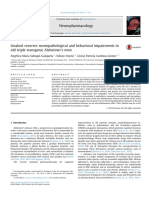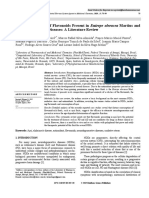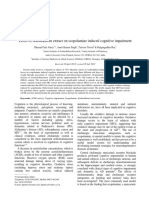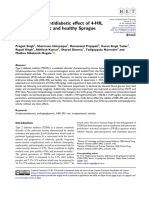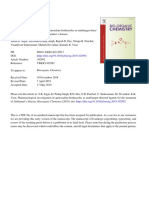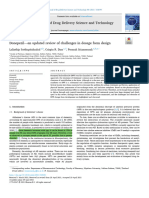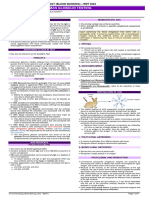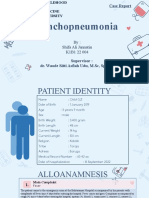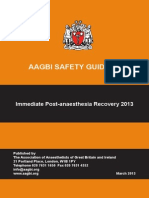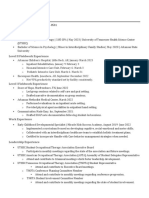Professional Documents
Culture Documents
Anti - Demential Effect of EGB 761 On Dementia Induced Wistar Rats
0 ratings0% found this document useful (0 votes)
55 views6 pagesDementia is a devastative neurodegenerative
disease which needs sufficient examinations on
successful treatment choices. Various studies have been
carried out to find therapeutic approaches for
dementia. Application of therapeutants and other
concoction drugs are not fruitful. A large portion of the
current drugs not perfect to treat the dementia because
of absence of particularity. Be that as it may, the
natural medicines are demonstrated as viable with
against dementia properties. A large number of plants
and plant constituents are being actively pursued for
the anti-dementia activity. In the present study
biochemical alterations in after induced dementia
treated with from EGB761 which is the standard
extract of Ginkgo Biloba Leaf Extract in combination
with frontline memory enhancing drug Donepezil in
different doses were investigated. Animals were
randomised and grouped based on the stratified body
weight Dementia were induced to all the animals (GII –
GVI) by intra peritoneal injection of scopolamine
except group I and VII. For group VII, animals were
treated with drug for a period of 6 weeks then dementia
were induced at the end of the treatment after 6 week
to assess the pretreatment effect of drug. Biochemical
analysis such as creatinine, cholesterol, sodium,
potassium, urea, HDL and LDL were also carried out
using standard procedures. The level of urea,
Creatinine, sodium, potassium, urea, creatinine,
cholesterol, HDL and LDL was observed at after
induced dementia with different treatments when
compared to scopolamine. EGB 761 could give
significant knowledge to development of newer lead
compounds against dementia.
Original Title
Anti - Demential Effect of EGB 761 on Dementia Induced Wistar Rats
Copyright
© © All Rights Reserved
Share this document
Did you find this document useful?
Is this content inappropriate?
Report this DocumentDementia is a devastative neurodegenerative
disease which needs sufficient examinations on
successful treatment choices. Various studies have been
carried out to find therapeutic approaches for
dementia. Application of therapeutants and other
concoction drugs are not fruitful. A large portion of the
current drugs not perfect to treat the dementia because
of absence of particularity. Be that as it may, the
natural medicines are demonstrated as viable with
against dementia properties. A large number of plants
and plant constituents are being actively pursued for
the anti-dementia activity. In the present study
biochemical alterations in after induced dementia
treated with from EGB761 which is the standard
extract of Ginkgo Biloba Leaf Extract in combination
with frontline memory enhancing drug Donepezil in
different doses were investigated. Animals were
randomised and grouped based on the stratified body
weight Dementia were induced to all the animals (GII –
GVI) by intra peritoneal injection of scopolamine
except group I and VII. For group VII, animals were
treated with drug for a period of 6 weeks then dementia
were induced at the end of the treatment after 6 week
to assess the pretreatment effect of drug. Biochemical
analysis such as creatinine, cholesterol, sodium,
potassium, urea, HDL and LDL were also carried out
using standard procedures. The level of urea,
Creatinine, sodium, potassium, urea, creatinine,
cholesterol, HDL and LDL was observed at after
induced dementia with different treatments when
compared to scopolamine. EGB 761 could give
significant knowledge to development of newer lead
compounds against dementia.
Copyright:
© All Rights Reserved
0 ratings0% found this document useful (0 votes)
55 views6 pagesAnti - Demential Effect of EGB 761 On Dementia Induced Wistar Rats
Dementia is a devastative neurodegenerative
disease which needs sufficient examinations on
successful treatment choices. Various studies have been
carried out to find therapeutic approaches for
dementia. Application of therapeutants and other
concoction drugs are not fruitful. A large portion of the
current drugs not perfect to treat the dementia because
of absence of particularity. Be that as it may, the
natural medicines are demonstrated as viable with
against dementia properties. A large number of plants
and plant constituents are being actively pursued for
the anti-dementia activity. In the present study
biochemical alterations in after induced dementia
treated with from EGB761 which is the standard
extract of Ginkgo Biloba Leaf Extract in combination
with frontline memory enhancing drug Donepezil in
different doses were investigated. Animals were
randomised and grouped based on the stratified body
weight Dementia were induced to all the animals (GII –
GVI) by intra peritoneal injection of scopolamine
except group I and VII. For group VII, animals were
treated with drug for a period of 6 weeks then dementia
were induced at the end of the treatment after 6 week
to assess the pretreatment effect of drug. Biochemical
analysis such as creatinine, cholesterol, sodium,
potassium, urea, HDL and LDL were also carried out
using standard procedures. The level of urea,
Creatinine, sodium, potassium, urea, creatinine,
cholesterol, HDL and LDL was observed at after
induced dementia with different treatments when
compared to scopolamine. EGB 761 could give
significant knowledge to development of newer lead
compounds against dementia.
Copyright:
© All Rights Reserved
You are on page 1of 6
Volume 4, Issue 2, February – 2019 International Journal of Innovative Science and Research Technology
ISSN No:-2456-2165
Anti - Demential Effect of EGB 761 on Dementia
Induced Wistar Rats
R. Vanitha Jebamalar Dr. S. Senthil Kumar
Research Scholar Professor of Anatomy
Meenakshi Academy of Higher Education and Research Sri Ramachandra Institute of Higher Education and Research
Chennai, India Chennai, India
Dr. Jaideep Mahendra Dr. Jayamathi Govindaraj
Director of Post Graduate Studies Professor of Biochemistry,
Faculty of Dentistry Sree Balaji Dental College and Hospital
Meenakshi Academy of Higher Education and Research Bharath Institute of Higher Education and Research
Chennai, India Chennai, India
Dr. P. Ramajayan
Veterinarian,
International Institute of Biotechnology and Toxicology
Chennai – India
Abstract:- Dementia is a devastative neurodegenerative I. INTRODUCTION
disease which needs sufficient examinations on
successful treatment choices. Various studies have been Dementia is alluded to as a gathering of chronic
carried out to find therapeutic approaches for disorders which is described by memory loss, improvement
dementia. Application of therapeutants and other of various cognitive deformities found in instances of
concoction drugs are not fruitful. A large portion of the adjusted physiological conditions. These adjusted
current drugs not perfect to treat the dementia because conditions are separate by changes in the character of an
of absence of particularity. Be that as it may, the individual joined by loss of intellectual function. The
natural medicines are demonstrated as viable with modification of the physiological conditions provoking
against dementia properties. A large number of plants dementia could be because of any medicine or on the other
and plant constituents are being actively pursued for hand numerous etiology prompting social and occupational
the anti-dementia activity. In the present study dysfunction [1]. Memory is the procedure by which
biochemical alterations in after induced dementia creatures can record their encounters and use this so as to
treated with from EGB761 which is the standard adjust their reactions to the nature. Subsequently it is
extract of Ginkgo Biloba Leaf Extract in combination imperative for survival. Impeded subjective capacities are
with frontline memory enhancing drug Donepezil in the real highlights of Alzheimer's disease. The ordinary
different doses were investigated. Animals were span of survival of AD patients after the start of dementia is
randomised and grouped based on the stratified body 5 to 9.3 years. As a result of absence of a permanent cure,
weight Dementia were induced to all the animals (GII – AD has transform into an imperative therapeutic issue, in
GVI) by intra peritoneal injection of scopolamine spite of the way that there are a couple of drugs that may
except group I and VII. For group VII, animals were back off its advances. It is assessed that there are 35.6
treated with drug for a period of 6 weeks then dementia million people living with dementia worldwide and would
were induced at the end of the treatment after 6 week have addition to 65.7 million by 2030, whereby an
to assess the pretreatment effect of drug. Biochemical extraordinary piece of the extension will be in developing
analysis such as creatinine, cholesterol, sodium, countries [2-3]. Several factors and conditions provoke
potassium, urea, HDL and LDL were also carried out dementia. These can be, Alzheimer's disease, dementia with
using standard procedures. The level of urea, Lewy bodies, vascular illness, heavy drinker dementia,
Creatinine, sodium, potassium, urea, creatinine, Creutzfeldt– Jakob sickness, Parkinson's ailment, hereditary
cholesterol, HDL and LDL was observed at after or a metabolic illness and harmful or an awful infection (4-
induced dementia with different treatments when 6). In recent years, several clinical studies have proposed
compared to scopolamine. EGB 761 could give what may be an important key in the progression of AD.
significant knowledge to development of newer lead The memory is the most imperative elements of the mind.
compounds against dementia. Application of therapeutants and other concoction drugs are
not fruitful. A large portion of the current drugs not perfect
Keywords:- EGB 761, Sodium, Potassium, Urea, to handle dementia because of absence of particularity. Be
Creatinine, Cholesterol, HDL and LDL. that as it may, the natural medicines are demonstrated as
viable with against dementia properties. They improve the
memory of dementia induced Wistar rats and incite the
regeneration of damaged nerve cells in brain and nerve
IJISRT19FB226 www.ijisrt.com 189
Volume 4, Issue 2, February – 2019 International Journal of Innovative Science and Research Technology
ISSN No:-2456-2165
tissues. The anti demential effects of a number of B. Induction of dementia
compounds were reported [7]. In the present study to Dementia was induced to all the animals (GII – GVI)
develop an effective anti demential compounds from EGB by intra peritoneal injection of scopolamine except group I
761 in combination with frontline memory enhancing drug and VII. For group VII, animals were treated with drug for
Donepezil in different doses. a period of 6 weeks then dementia was induced at the end
of the treatment after 6 week to assess the pretreatment
Ginkgo Biloba have been used as agents for effect of drug. Biochemical analysis such as sodium,
improving cerebral circulation and exhibits various potassium, urea, creatinine, cholesterol, HDL and LDL
biological activities such as antioxidant, anti-parasitic, anti- were also carried out using standard procedures.
tumor and anti-viral activities. It possessed
phytoconstituents such as phenolic acids, C. Assay for serum total cholesterol
proanthocyanidins, flavonoid glycosides, biflavones, as The level of serum in total cholesterol was measured
well as alkylphenols and polyprenols [8]. EGB 761 is the after enzymatic hydrolysis and oxidation of the sample as
standard extract of Ginkgo Biloba Leaf Extract. depicted by the technique of Stein [13]. Quickly, 1000: l of
Biochemical analysis such as sodium, potassium, urea, the reagent was added to all the test sample and standard.
creatinine, cholesterol, HDL and LDL plays a crucial role in This was brooded for 10 minutes at 20-25ºC in the wake of
the development of mild cognitive impairment (MCI) and blending and the absorbance of the example (A sample) and
AD. Depressed sodium and potassium levels might lead to a standard (A standard) was estimated against the reagent
cellular ion imbalance. Renal capacity decreases with age clear inside 30 minutes at 546 nm. The estimation of Total
and as per the burden of vascular risk factors, while serum Cholesterol present in serum was expressed in the unit of
creatinine and proteinuria have been related with late life mg/dL.
occurrence all-cause dementia. Both low and high
glomerular filtration rates might be valuable markers for D. Assay for serum high density lipoprotein cholesterol
mortality and cardiovascular occasions, while hereditary The serum level of high density lipoprotein
impacts may be essential to interfere those dangers [9-10]. cholesterol HDL-C was estimated by the method of Wacnic
Metabolic syndrome is a multifactorial disorder represented and Alber [14]. Low-density lipoproteins and chylomicron
by the co-occurrence of vascular conditions related to fractions in the sample were precipitated quantitatively by
impaired glucose metabolism and dyslipidemia. Each addition of phosphotungstic acid in the presence of
individual factor and metabolic syndrome as a whole has magnesium ions. The mixture of the sample was kept for 10
been repeatedly correlated with cognitive decline and minutes at room temperature and centrifuged at 4000 rpm
dementia [11-12]. Keeping in this view the present for 10 minutes. The supernatant described the HDL-C
investigation was undertaken to elucidate the biochemical fraction. The cholesterol concentration in the HDL fraction,
alterations in after induced dementia treated with from EGB which remained in the supernatant, was determined. The
761 in combination with frontline memory enhancing drug value of HDL-C was expressed in the unit of mg/dl.
Donepezil in different doses.
E. Determination of serum low-density lipoprotein
II. MATERIALS AND METHODS The serum level of (LDL-C) was measured according
to protocol of Friedewald et al.[15] The value was
A. Experimental design expressed in the unit of mg/dL
Animals were randomised and grouped based on the
stratified body weight. The weight variation of mouse was III. STATISTICAL ANALYSIS
minimal and not exceeds ± 20% of the mean body weight.
The weights of each mouse were measured before starting All the results and data were expressed as mean ± standard
the experiment. Prior to the experiments, random sampling deviation. Data was analyzed using two way ANOVA by
was made among the animals to detect any external bonferroni test and one way ANOVA tukey’s test. (P< 0.05
perceptive symptoms, to ensure that the Wistar rats were and P< 0.001) was considered as statistically significant.
free from disease/infections. Group I as Control (Normal
saline), Group II as positive control (Scopolamine 1mg/kg + IV. RESULTS AND DISCUSSION
Normal saline), Group III as reference drug (Scopolamine
1mg/kg + Donepezil 10mg/kg), Group IV served as In the present investigation anti demential effect of EGB
reference drug (scopolamine 1 mg/kg + Donepezil 761 on biochemical analysis such as sodium, potassium,
20mg/kg), Group V served as Test drug (Scopolamine 1 urea, creatinine, cholesterol, HDL and LDL were studied.
mg/kg + EGB 761 100 mg/kg), Group VI served as Test
drug (Scopolamine 1 mg/kg + EGB 761 200 mg/kg) and F. Sodium and Potassium
Group VII served as Test drug (EGB 761 100 mg/kg + It was observed that administration of Scopolamine
Scopolamine 1 mg/kg). and normal saline (Group II) increased the level of sodium
and potassium and it was found to be 175.83 ± 1.58 and
2.59 ± 0.07. Likewise, EGB 761 and Scopolamine (Group
VII) extract also significantly increased the level of sodium
and potassium in after induced dementia was found to be
148.45 ± 1.25 and 4.39 ± 0.34 respectively (P< 0.05 and P<
IJISRT19FB226 www.ijisrt.com 190
Volume 4, Issue 2, February – 2019 International Journal of Innovative Science and Research Technology
ISSN No:-2456-2165
0.001) (Table 1 and Fig.1). Moderate level of elevation in intervened and independent of blood pressure variations in
sodium and potassium was observed at Group III and the older people with AD. Modifications in urea and creatinine
decreased level of sodium and potassium was observed at invigorated by scopolamine were altogether prevented by
Group IV in after induced dementia. Our results were akin EGB 761.
with Ozawa et al [16] who observed that the dietary intake
of potassium, magnesium and calcium declined the risk of C.Total cholesterol, HDL and LDL
dementia mainly in vascular dementia. The risk of AD In the present study, total cholesterol, HDL and LDL
would in general decrease with higher detailed dietary in dementia induced Wistar rats was investigated. After
mineral intake, but there was no significant linear induced dementia treatment, total cholesterol level was
progression. Likewise, Cisternas et al.[17] who observed increased in Group III was found to be 192.43 ± 1.82 and
that the increase in the intake of K+ could help to prevent the decreased level of was observed at Group VI and VII
the pathologies such as hypertension, which could possibly was found to be 159.43 ± 1.12 and 180.64 ± 1.43. Likewise,
prevent or retard the onset of cognitive-related diseases HDL was increased in Group V, VI and VII was found to
such as AD. The positive effects represented for the K+ diet be 82.21 ± 0.47 and decreased in Group III, II and I was
could be an interesting non-pharmacological treatment at found to be 53.48 ± 0.32, 51.26 ± 0.28 and 66.83 ± 0.32 (P<
least to some extent, the incidence of cognitive decline and 0.05 and P< 0.001) respectively (Table3 and Fig.3). Our
the progression of AD. results were substantiating with Dubey [20] who recorded
that the significant lowering of serum cholesterol in EGB
G. Urea and Creatinine 761 treated animals, almost comparable to that of lovastatin
A significant variation of urea and creatinine was B. Similarly, disturbances in cholesterol, HDL and LDL
observed in after induced dementia at all the treatment indicate disturbances in protein, carbohydrate and lipid
groups. Maximum level of inhibition was observed at metabolism induced by thioacetamide intoxication was
(Group V) Scopolamine + EGB761 on urea and creatinine reported by Al-Attar [21]. Ismail et al. [22] also observed
was found to be 49.88 ± 0.58, 0.88 ± 0.04 and 42.69 ± 0.53, the levels of serum cholesterol and LDL were increased,
0.67 ± 0.09. Likewise, Scopolamine + EGB 761 (Group while the level of serum HDL was declined in CCl4 treated
V1) was showed 45.41 ± 0.43, 0.72 ± 0.03 and 41.42 ± rats. Low level of HDL may be a risk factor for loss of
0.36, 0.64 ± 0.08 respectively (P<0.05) (Table 2 and Fig.2). memory lead to dementia. EGB 761 has a potential anti
Similar observations was recorded by Chaturvedi et al [18] demential activity in Wistar rats compared to Donepezil.
who reported the significant increased level in the blood These results suggest that EGB 761 can be used as a
urea nitrogen, due to a metabolic cause in dementia. valuable or effective herbal drug to combat dementia
Ferreira de Oliveira [19] additionally considered the patients.
impacts of ACE is over creatinine varieties are hereditarily
Without dementia Treatment After induced dementia Treatment
S. No Group
Sodium Potassium Sodium Potassium
1. Normal saline 135.74 ± 1.21 3.91 ± 0.12 135.84 ± 1.20 4.36 ± 0.32
2. Scopolamine + Normal saline 142.82 ± 1.30 3.75 ± 0.10 175.83 ± 1.58 2.59 ± 0.07
3. Scopolamine + Donepezil 140.02 ± 1.27 4.36 ± 0.32 149.23 ± 1.30 3.64 ± 0.10
4. Scopolamine + Donepezil 150.19 ± 1.32 4.71 ± 0.38 126.43 ± 1.11 3.89 ± 0.11
5. Scopolamine + EGB 761 140.81 ± 1.25 3.91 ± 0.12 144.18 ± 1.24 4.15 ± 0.18
6. Scopolamine + EGB 761 138.39 ± 1.23 3.91 ± 0.12 142.41 ± 1.23 4.01 ± 0.12
7. EGB 761 + Scopolamine 136.82 ± 1.19 4.36 ± 0.31 148.45 ± 1.25 4.39 ± 0.34
Table 1:- Sodium and Potassium Level of Dementia in Different Treatment Groups
Without dementia Treatment After induced dementia Treatment
S. No Group
Urea Creatinine Urea Creatinine
1. Normal saline 44.31 ± 0.41 0.78 ± 0.03 44.13 ±0.42 0.59 ± 0.07
2. Scopolamine + Normal saline 44.09 ± 0.41 0.82 ± 0.04 59.43 ± 0.68 1.79 ± 0.4
3. Scopolamine + Donepezil 47.39 ± 0.50 0.78 ± 0.03 49.64 ± 0.59 1.02 ± 0.1
4. Scopolamine + Donepezil 48.38 ± 0.54 0.76 ± 0.03 44.39 ± 0.42 0.92 ± 0.1
5. Scopolamine + EGB 761 49.88 ± 0.58 0.88 ± 0.04 42.69 ± 0.53 0.67 ± 0.09
6. Scopolamine + EGB 761 45.41 ± 0.43 0.72 ± 0.03 41.42 ± 0.36 0.64 ± 0.08
7. EGB 761 + Scopolamine 43.71 ± 0.38 0.65 ± 0.03 44.28 ± 0.41 0.66 ± 0.08
Table 2:- Urea and Creatinine Level of Dementia in Different Treatment Groups
IJISRT19FB226 www.ijisrt.com 191
Volume 4, Issue 2, February – 2019 International Journal of Innovative Science and Research Technology
ISSN No:-2456-2165
Without dementia Treatment After induced dementia Treatment
S. No Group
TC HDL LDL TC HDL LDL
180.12 ± 67.83 ± 122.39 ± 179.12 ± 118.17 ±
1. Normal saline 66.83 ± 0.32
1.68 0.63 0.69 1.52 1.12
192.34 ± 55.83 ± 118.42 ± 198.27 ± 129.67 ±
2. Scopolamine + Normal saline 51.26 ± 0.28
1.72 0.48 0.62 1.68 1.32
171.48 ± 60.46 ± 110.25 ± 188.63 ± 139.75 ±
3. Scopolamine + Donepezil 53.48 ± 0.32
1.56 0.59 0.57 1.70 0.98
187.53 ± 54.35 ± 131.28 ± 192.43 ± 121.31 ±
4. Scopolamine + Donepezil 69.31 ± 0.43
1.70 0.47 0.49 1.82 1.11
165.69 ± 52.25 ± 0. 120.65 ± 140.23 ± 112.67 ±
5. Scopolamine + EGB 761 74.24 ± 0.53
1.43 43 0.54 1.03 1.04
169.78 ± 68.26 ± 116.71 ± 159.43 ± 114.47 ±
6. Scopolamine + EGB 761 82.21 ± 0.47
1.47 0.32 0.43 1.12 1.21
185.76 ± 57.31 ± 118.43 ± 180.64 ± 118.64 ±
7. EGB 761 + Scopolamine 65.29 ± 0.33
1.73 0.31 0.42 1.43 0.99
Table 3:- Total Cholesterol, HDL and LDL Level of Dementia in Different Treatment Groups
Fig 1:- Sodium and Potassium Level of Dementia in Different Treatment Groups
Fig 2:- Urea and Creatinine Level of Dementia in Different Treatment Groups
IJISRT19FB226 www.ijisrt.com 192
Volume 4, Issue 2, February – 2019 International Journal of Innovative Science and Research Technology
ISSN No:-2456-2165
Fig 3:- Cholestrol, HDL and LDL Level of Dementia in Different Treatment Groups
V. CONCLUSION [5]. McKhann G, Drachman D, Folstein M, Katzman R,
Price D, Stadlan EM: Clinical diagnosis of
Anti-demential effect of EGB 761 on biochemical Alzheimer’s disease: report of the NINCDS-ADRDA
analysis such as sodium, potassium, urea, creatinine, Work Group under the auspices of Department of
cholesterol, HDL and LDL were studied. EGb761 affects Health and Human Services Task Force on
the mechanisms associated with proper brain functions. A Alzheimer’s Disease. Neurology 1984; 34: 939–944.
major chemical constituent occurs in Gingko Biloba is [6]. Chui HC, Victoroff JI, Margolin D, Jagust W,
gingkolides and it is a pertinent antioxidant, with Shankle R, Katzman R: Criteria for the diagnosis of
neuroprotective and cholinergic activities that works in the ischemic vascular dementia proposed by the State of
management of AD. EGb761 altered the biochemical California Alzheimer’s Disease Diagnostic and
parameters in dementia treated rats when compared to Treatment Centers. Neurology 1992; 42: 473–480.
Donepezil. EGB 761 also protected rodent neurons and [7]. Sobhani, R., Pal, A. K., Bhattacharjee, A., Mitra, S.,
glial cells against cerebral ischemia or scopolamine induced & Aguan, K. (2017). Screening Indigenous Medicinal
toxicity. Plants of Northeast India for Their Anti-Alzheimer’s
Properties. Pharmacognosy Journal, 9(1).
EGB 761 can be used as an efficacious herbal [8]. Van Beek T. A, Montoro P (2009). "Chemical
treatment to prevent and might be a promising therapeutic analysis and quality control of Ginkgo biloba leaves,
agent for anti-demential properties and speculate that extracts, and phytopharmaceuticals". J
Ginkgo Biloba extract may reach the market in near future. Chromatography A 1216 (11): 2002–2032.
[9]. Peters R, Beckett N, Poulter R, Burch L, Narkiewicz
ACKNOWLEDGMENT K, Fagard R, et al. Kidney function in the very
elderly with hypertension: data from the hypertension
I would like to thank my supervisor Dr. S. Senthil in the very elderly (HYVET) trial. Age Ageing.
Kumar, my Co supervisor Dr. Jaideep Mahendra and my 2013; 42: 253–8.
family members for their guidance and support. [10]. Higuchi M, Chen R, Abbott RD, Bell C, Launer L,
Ross GW, et al. Mid-life proteinuria and late-life
REFERENCES cognitive function and dementia in elderly men: The
Honolulu-Asia aging study. Alzheimer Dis Assoc
[1]. Dixit A, Lakshmi V, Chouhan S, Vaney N. Alteration Disord. 2015; 29: 200–5.
in Oxidative Stress Markers in Blood of Patients with [11]. Luchsinger JA. Diabetes, related conditions, and
Dementia. Indian Journal of Medical dementia. J Neurol Sci. 2010;299:35–38
Specialities.2010;1(1):26-29 [12]. Li J, et al. Vascular risk factors promote conversion
[2]. Walsh JS, Welch G, Larson EB, Welch HG. Survival from mild cognitive impairment to Alzheimer
of outpatients with Alzheimer-type dementia. Ann disease.
Intern Med. 1990;113(6):429-34. [13]. Stein, E.A., 1987. Lipids, lipoproteins and
[3]. Chu J, Li JG, Joshi YB, Giannopoulos PF, Hoffman Apolipoproteins. In: N.W. Treitz, (Ed.),
NE, Madesh M, et al.,Gamma secretase-activating Fundamentals of Clinical Chemistry. 3rd Edn., W.B
protein is a substrate for caspase-3: implications for Sauders, Philadelphia, pp: 470-479.
alzheimer’s disease. Biological psychiatry. [14]. Wacnic, R.G. and J.J. Alber, 1978. A comprehensive
2015;77(8):720-8. evaluation of the heparin manganese precipitation
[4]. Peterson RP: Mild cognitive impairment as a procedure for estimating high density lipoprotein
diagnostic entity. J Intern Med 2004; 256: 183–194. cholesterol. J Lipid Res.,19: 65-76.
IJISRT19FB226 www.ijisrt.com 193
Volume 4, Issue 2, February – 2019 International Journal of Innovative Science and Research Technology
ISSN No:-2456-2165
[15]. Chaturvedi, A., Natarajan, A., Sharma, V., Yaparthy,
N., Shetty, J. K., Virupaksha, D., ... & Prakash, M.
(2015). Association of age related severity in
oxidative stress and blood urea nitrogen levels in
patients with dementia: A coastal Karnataka study.
Asian Journal of Biomedical and Pharmaceutical
Sciences, 5(44).
[16]. Ozawa M, Ninomiya T, Ohara T, Hirakawa Y, Doi
Y, Hata J, Uchida K, Shirota T, Kitazono T,
Kiyohara Y: Selfreported dietary intake of potassium,
calcium, and magnesium and risk of dementia in the
Japanese: the Hisayama Study. J Am Geriatr Soc
2012;60:1515–1520
[17]. Cisternas P, Lindsay CB, Salazar P, Silva-Alvarez C,
Retamales RM, Serrano FG, Vio CP, Inestrosa NC:
The increased potassium intake improves cognitive
performance and attenuates histopathological
markers in a model of Alzheimer’s disease. Biochim
Biophys Acta 2015;1852:2630–2644
[18]. Oliveira, F., Berretta, J. M., Suchi Chen, E., Cardoso
Smith, M., & Ferreira Bertolucci, P. H. (2016).
Pharmacogenetic effects of angiotensin-converting
enzyme inhibitors over age-related urea and
creatinine variations in patients with dementia due to
Alzheimer disease. Colombia Médica, 47(2), 76-80.
[19]. Friedewald, W.T., R. Levy and D.S. Fradrickson,
1972. Estimation of concentration of low density
lipoprotein cholesterol in plasma without the use of
preparative ultracentrifugation. Clin. Chem., 19: 449-
452
[20]. Dubey, A. K., Devi, A., Kutty, G., & Shankar, R. P.
(2005). Hypolipidemic activity of Ginkgo biloba
extract, EGb 761 in hypercholesterolemic wistar rats.
IJPT, 4(1), 9-12.
[21]. Al-Attar, A. M. (2012). Attenuating effect of Ginkgo
biloba leaves extract on liver fibrosis induced by
thioacetamide in mice. BioMed Research
International, 2012.
IJISRT19FB226 www.ijisrt.com 194
You might also like
- Autism Spectrum Disorder: Bioregenerative Medicine With Stem Cell TherapyFrom EverandAutism Spectrum Disorder: Bioregenerative Medicine With Stem Cell TherapyNo ratings yet
- Potential of Solanum Betaceum To Improve Cognition: A Systematic Review of Animal StudiesDocument13 pagesPotential of Solanum Betaceum To Improve Cognition: A Systematic Review of Animal StudiesJournal of Pharmacy & Pharmacognosy ResearchNo ratings yet
- Brain Tissue Homogenate Preparation - PDF 2Document8 pagesBrain Tissue Homogenate Preparation - PDF 2Ashok KumarNo ratings yet
- Zingerone Sci - Pharmacotherapeutic Potential of Ginger and Its Compounds in Age-Related Neurological DisordersDocument15 pagesZingerone Sci - Pharmacotherapeutic Potential of Ginger and Its Compounds in Age-Related Neurological DisordersyunusNo ratings yet
- Flavonoids As Prospective Neuroprotectants and Their Therapeutic Propensity in Aging Associated Neurological DisordersDocument20 pagesFlavonoids As Prospective Neuroprotectants and Their Therapeutic Propensity in Aging Associated Neurological DisordersThư PhạmNo ratings yet
- 07 Ijpscr 143 23Document9 pages07 Ijpscr 143 23BRNSS Publication Hub InfoNo ratings yet
- Linalool Reverses Neuropathological and Behavioral ImpairmentsDocument10 pagesLinalool Reverses Neuropathological and Behavioral ImpairmentsCamila CellyNo ratings yet
- 10 1089@jmf 2016 3740Document10 pages10 1089@jmf 2016 3740Tim WongNo ratings yet
- Vitamin D Deficiency Linked to Newly Diagnosed Idiopathic Epilepsy in ChildrenDocument5 pagesVitamin D Deficiency Linked to Newly Diagnosed Idiopathic Epilepsy in ChildrenFihzanNo ratings yet
- Alkhalaf 2020Document10 pagesAlkhalaf 2020refilda suhailiNo ratings yet
- Photobiomodulation With Near Infrared Light Helmet in A Pilot Placebo Controlled Clinical Trial in Dementia Patients Testing MemorDocument8 pagesPhotobiomodulation With Near Infrared Light Helmet in A Pilot Placebo Controlled Clinical Trial in Dementia Patients Testing MemorarexixNo ratings yet
- The Ketogenic Diet As A Non Pharmacological Treatment For HIV Associated Neurocognitive Disorder A Descriptive AnalysisDocument5 pagesThe Ketogenic Diet As A Non Pharmacological Treatment For HIV Associated Neurocognitive Disorder A Descriptive AnalysisPaul HartingNo ratings yet
- Ni Hms 557729Document18 pagesNi Hms 557729Made DeddyNo ratings yet
- 1 s2.0 S1875536417300936 MainDocument12 pages1 s2.0 S1875536417300936 MainZaldaa ZaldaaNo ratings yet
- Jmf.2020.0137-Genoderma in PDDocument8 pagesJmf.2020.0137-Genoderma in PDApostolos T.No ratings yet
- High-Dose Thiamine Improves Parkinson's SymptomsDocument9 pagesHigh-Dose Thiamine Improves Parkinson's SymptomsSOCIETE S.T.HNo ratings yet
- Efficacy and Adverse Effects of Ginkgo Biloba For Cognitive Impairment and Dementia: A Systematic Review and Meta-AnalysisDocument15 pagesEfficacy and Adverse Effects of Ginkgo Biloba For Cognitive Impairment and Dementia: A Systematic Review and Meta-AnalysisjosetelhadoNo ratings yet
- De Oliveira 2019Document25 pagesDe Oliveira 2019BRUNO JOSE BRITO TEIXEIRANo ratings yet
- The_Effect_of_Folic_Acid_Adjuvant_on_Cognitive_FunDocument6 pagesThe_Effect_of_Folic_Acid_Adjuvant_on_Cognitive_FunSafira AiinatunnisaNo ratings yet
- Akintoye Et Al LicoriceDocument7 pagesAkintoye Et Al LicoriceAkestNo ratings yet
- Euro J of Neurology - 2006 - Mazza - Ginkgo Biloba and Donepezil A Comparison in The Treatment of Alzheimer S Dementia in PDFDocument5 pagesEuro J of Neurology - 2006 - Mazza - Ginkgo Biloba and Donepezil A Comparison in The Treatment of Alzheimer S Dementia in PDFIraidaCanudasHernandezNo ratings yet
- 1 s2.0 S2666459322000257 MainDocument10 pages1 s2.0 S2666459322000257 MainEmmanuel OwonaNo ratings yet
- Article ParulDocument11 pagesArticle ParulMysterious EggNo ratings yet
- Antidiabetic and Hypolipidemic Effect of Methanol e - 2011 - Asian Pacific JournDocument7 pagesAntidiabetic and Hypolipidemic Effect of Methanol e - 2011 - Asian Pacific JourneulaliavNo ratings yet
- Alzheimer Disease: Review ArticleDocument16 pagesAlzheimer Disease: Review Articlefernandosousa7No ratings yet
- Article Ejbps Volume 6 August Issue 8 1564793897Document8 pagesArticle Ejbps Volume 6 August Issue 8 1564793897Rashid IqbalNo ratings yet
- Journal Pre-Proof: Pharmacology, Biochemistry and BehaviorDocument39 pagesJournal Pre-Proof: Pharmacology, Biochemistry and BehaviorPAOLA REGINA GOMEZ ALVANo ratings yet
- Effect of Seabuckthorn Extract On Scopolamine Induced Cognitive ImpairmentDocument6 pagesEffect of Seabuckthorn Extract On Scopolamine Induced Cognitive ImpairmentMaria-Madalina BodescuNo ratings yet
- Zhang 2018Document7 pagesZhang 2018Jonas Ricardo Pereira Júnior RicardoNo ratings yet
- Molecules 27 03737Document41 pagesMolecules 27 03737Daniel ChaguenNo ratings yet
- Assessment of Antidiabetic Effect of 4-HIL in Type 2 Diabetic and Healthy Sprague Dawley RatsDocument11 pagesAssessment of Antidiabetic Effect of 4-HIL in Type 2 Diabetic and Healthy Sprague Dawley RatsMaxin BangsalNo ratings yet
- Antidiabetic Activity of Plants ThesisDocument8 pagesAntidiabetic Activity of Plants Thesisygsyoeikd100% (1)
- Antioxidants and Anti-Inflammation Potentialof Amaranthus Viridis Linn Against 3-Np-Induced Huntingtons Disease in RatsDocument10 pagesAntioxidants and Anti-Inflammation Potentialof Amaranthus Viridis Linn Against 3-Np-Induced Huntingtons Disease in RatsIJAR JOURNALNo ratings yet
- Ketogenic Diets and Alzheimers DiseaseDocument9 pagesKetogenic Diets and Alzheimers DiseaseCaro GonzalezAFNo ratings yet
- Neuroprotective Peptides As Drug Candidates AgainsDocument8 pagesNeuroprotective Peptides As Drug Candidates Againsancuta.lupaescuNo ratings yet
- The Effect of Vitamin D Supplementation On Depressive Symptoms in Adults A Systematic Review and Meta Analysis of Randomized Controlled TrialsDocument19 pagesThe Effect of Vitamin D Supplementation On Depressive Symptoms in Adults A Systematic Review and Meta Analysis of Randomized Controlled TrialsEmillya SariNo ratings yet
- Natural Prod Ucts and Their Derivatives As Multif UnctionalDocument19 pagesNatural Prod Ucts and Their Derivatives As Multif UnctionalyusufNo ratings yet
- Stroke Rehab NIDocument11 pagesStroke Rehab NIFruzsina ÜrmösNo ratings yet
- Review Article Hericium Erinaceus Mycelia: Neurohealth Properties of Enriched With ErinacinesDocument10 pagesReview Article Hericium Erinaceus Mycelia: Neurohealth Properties of Enriched With ErinacinesJames Le Tan Thanh TungNo ratings yet
- Neurohealth Properties of Hericium Erinaceus MycelDocument11 pagesNeurohealth Properties of Hericium Erinaceus Myceldokan42No ratings yet
- Mills & Tamnes, 2014.methods and Considerations For Longitudinal Structural Brain Imaging Analysis Across DevelopmentDocument10 pagesMills & Tamnes, 2014.methods and Considerations For Longitudinal Structural Brain Imaging Analysis Across DevelopmentSu AjaNo ratings yet
- Biomolecules 11 00543Document19 pagesBiomolecules 11 00543gamers juarezNo ratings yet
- Out - 2021-11-20T082541.533Document14 pagesOut - 2021-11-20T082541.533Mina PuspoNo ratings yet
- Ayurvedic Medicinal Plants For Alzheimer's DiseaseDocument9 pagesAyurvedic Medicinal Plants For Alzheimer's Diseasejcamacho95No ratings yet
- Perspective Is Therapeutic Plasma Exchange A Viable Option For TreatingDocument11 pagesPerspective Is Therapeutic Plasma Exchange A Viable Option For TreatingRaul Rios RitterNo ratings yet
- 21.ENG - Oxidative Stress in ADDocument11 pages21.ENG - Oxidative Stress in ADFarhan Royan PermanahadiNo ratings yet
- Farlow - Treatment OptionsDocument16 pagesFarlow - Treatment OptionsaruesjasNo ratings yet
- Quinoxaline-bisthiazoles show promise for Alzheimer's treatmentDocument43 pagesQuinoxaline-bisthiazoles show promise for Alzheimer's treatmentNeetika TanejaNo ratings yet
- Journal of Drug Delivery Science and Technology: Lalinthip Sutthapitaksakul, Crispin R. Dass, Pornsak SriamornsakDocument12 pagesJournal of Drug Delivery Science and Technology: Lalinthip Sutthapitaksakul, Crispin R. Dass, Pornsak SriamornsakLi LianNo ratings yet
- Abib 2010 jmf.2009.0255Document5 pagesAbib 2010 jmf.2009.0255Paula LunardiNo ratings yet
- A Systematic Review On Etiology, Epidemiology, and Treatment of CPDocument10 pagesA Systematic Review On Etiology, Epidemiology, and Treatment of CPЯковлев АлександрNo ratings yet
- Pharmaceutical Applications of Extracted Phycocyanin From Arthrospira PlatensisDocument11 pagesPharmaceutical Applications of Extracted Phycocyanin From Arthrospira PlatensisInternational Journal of Innovative Science and Research TechnologyNo ratings yet
- Effect of Photobiomodulation in MultiplesclerosisDocument4 pagesEffect of Photobiomodulation in MultiplesclerosisMuhammad Imam NoorNo ratings yet
- Bartlett 2020Document9 pagesBartlett 2020Erick SolisNo ratings yet
- Formolo D. A., Et Al. (2019) - Deep Brain Stimulation For Obesity ReviewDocument13 pagesFormolo D. A., Et Al. (2019) - Deep Brain Stimulation For Obesity ReviewHiago MeloNo ratings yet
- Current Neuropharmacology-PaperDocument14 pagesCurrent Neuropharmacology-PapermishaelalexNo ratings yet
- Article 4 2020 Functional FoodsDocument12 pagesArticle 4 2020 Functional FoodsEL MOSTAFI HICHAMNo ratings yet
- Kami Export - Chopra, Nanomedicines in The Management of Alzheimer's Disease - Current View and Future ProspectsDocument17 pagesKami Export - Chopra, Nanomedicines in The Management of Alzheimer's Disease - Current View and Future ProspectsДаниал АхатNo ratings yet
- GC-MS-Based Metabolomic Study On The Antidepressant-Like Effects of Diterpene Ginkgolides in Mouse..Document10 pagesGC-MS-Based Metabolomic Study On The Antidepressant-Like Effects of Diterpene Ginkgolides in Mouse..Hitesh VermaNo ratings yet
- Automatic Power Factor ControllerDocument4 pagesAutomatic Power Factor ControllerInternational Journal of Innovative Science and Research TechnologyNo ratings yet
- Intelligent Engines: Revolutionizing Manufacturing and Supply Chains with AIDocument14 pagesIntelligent Engines: Revolutionizing Manufacturing and Supply Chains with AIInternational Journal of Innovative Science and Research TechnologyNo ratings yet
- Navigating Digitalization: AHP Insights for SMEs' Strategic TransformationDocument11 pagesNavigating Digitalization: AHP Insights for SMEs' Strategic TransformationInternational Journal of Innovative Science and Research TechnologyNo ratings yet
- A Review: Pink Eye Outbreak in IndiaDocument3 pagesA Review: Pink Eye Outbreak in IndiaInternational Journal of Innovative Science and Research TechnologyNo ratings yet
- Teachers' Perceptions about Distributed Leadership Practices in South Asia: A Case Study on Academic Activities in Government Colleges of BangladeshDocument7 pagesTeachers' Perceptions about Distributed Leadership Practices in South Asia: A Case Study on Academic Activities in Government Colleges of BangladeshInternational Journal of Innovative Science and Research TechnologyNo ratings yet
- Securing Document Exchange with Blockchain Technology: A New Paradigm for Information SharingDocument4 pagesSecuring Document Exchange with Blockchain Technology: A New Paradigm for Information SharingInternational Journal of Innovative Science and Research TechnologyNo ratings yet
- Mobile Distractions among Adolescents: Impact on Learning in the Aftermath of COVID-19 in IndiaDocument2 pagesMobile Distractions among Adolescents: Impact on Learning in the Aftermath of COVID-19 in IndiaInternational Journal of Innovative Science and Research TechnologyNo ratings yet
- Studying the Situation and Proposing Some Basic Solutions to Improve Psychological Harmony Between Managerial Staff and Students of Medical Universities in Hanoi AreaDocument5 pagesStudying the Situation and Proposing Some Basic Solutions to Improve Psychological Harmony Between Managerial Staff and Students of Medical Universities in Hanoi AreaInternational Journal of Innovative Science and Research TechnologyNo ratings yet
- Review of Biomechanics in Footwear Design and Development: An Exploration of Key Concepts and InnovationsDocument5 pagesReview of Biomechanics in Footwear Design and Development: An Exploration of Key Concepts and InnovationsInternational Journal of Innovative Science and Research TechnologyNo ratings yet
- Perceived Impact of Active Pedagogy in Medical Students' Learning at the Faculty of Medicine and Pharmacy of CasablancaDocument5 pagesPerceived Impact of Active Pedagogy in Medical Students' Learning at the Faculty of Medicine and Pharmacy of CasablancaInternational Journal of Innovative Science and Research TechnologyNo ratings yet
- Formation of New Technology in Automated Highway System in Peripheral HighwayDocument6 pagesFormation of New Technology in Automated Highway System in Peripheral HighwayInternational Journal of Innovative Science and Research TechnologyNo ratings yet
- Natural Peel-Off Mask Formulation and EvaluationDocument6 pagesNatural Peel-Off Mask Formulation and EvaluationInternational Journal of Innovative Science and Research TechnologyNo ratings yet
- Drug Dosage Control System Using Reinforcement LearningDocument8 pagesDrug Dosage Control System Using Reinforcement LearningInternational Journal of Innovative Science and Research TechnologyNo ratings yet
- The Effect of Time Variables as Predictors of Senior Secondary School Students' Mathematical Performance Department of Mathematics Education Freetown PolytechnicDocument7 pagesThe Effect of Time Variables as Predictors of Senior Secondary School Students' Mathematical Performance Department of Mathematics Education Freetown PolytechnicInternational Journal of Innovative Science and Research TechnologyNo ratings yet
- Enhancing the Strength of Concrete by Using Human Hairs as a FiberDocument3 pagesEnhancing the Strength of Concrete by Using Human Hairs as a FiberInternational Journal of Innovative Science and Research TechnologyNo ratings yet
- Supply Chain 5.0: A Comprehensive Literature Review on Implications, Applications and ChallengesDocument11 pagesSupply Chain 5.0: A Comprehensive Literature Review on Implications, Applications and ChallengesInternational Journal of Innovative Science and Research TechnologyNo ratings yet
- Advancing Opthalmic Diagnostics: U-Net for Retinal Blood Vessel SegmentationDocument8 pagesAdvancing Opthalmic Diagnostics: U-Net for Retinal Blood Vessel SegmentationInternational Journal of Innovative Science and Research TechnologyNo ratings yet
- The Making of Self-Disposing Contactless Motion-Activated Trash Bin Using Ultrasonic SensorsDocument7 pagesThe Making of Self-Disposing Contactless Motion-Activated Trash Bin Using Ultrasonic SensorsInternational Journal of Innovative Science and Research TechnologyNo ratings yet
- Placement Application for Department of Commerce with Computer Applications (Navigator)Document7 pagesPlacement Application for Department of Commerce with Computer Applications (Navigator)International Journal of Innovative Science and Research TechnologyNo ratings yet
- REDLINE– An Application on Blood ManagementDocument5 pagesREDLINE– An Application on Blood ManagementInternational Journal of Innovative Science and Research TechnologyNo ratings yet
- Beyond Shelters: A Gendered Approach to Disaster Preparedness and Resilience in Urban CentersDocument6 pagesBeyond Shelters: A Gendered Approach to Disaster Preparedness and Resilience in Urban CentersInternational Journal of Innovative Science and Research TechnologyNo ratings yet
- Exploring the Clinical Characteristics, Chromosomal Analysis, and Emotional and Social Considerations in Parents of Children with Down SyndromeDocument8 pagesExploring the Clinical Characteristics, Chromosomal Analysis, and Emotional and Social Considerations in Parents of Children with Down SyndromeInternational Journal of Innovative Science and Research TechnologyNo ratings yet
- Handling Disruptive Behaviors of Students in San Jose National High SchoolDocument5 pagesHandling Disruptive Behaviors of Students in San Jose National High SchoolInternational Journal of Innovative Science and Research TechnologyNo ratings yet
- Safety, Analgesic, and Anti-Inflammatory Effects of Aqueous and Methanolic Leaf Extracts of Hypericum revolutum subsp. kenienseDocument11 pagesSafety, Analgesic, and Anti-Inflammatory Effects of Aqueous and Methanolic Leaf Extracts of Hypericum revolutum subsp. kenienseInternational Journal of Innovative Science and Research TechnologyNo ratings yet
- A Curious Case of QuadriplegiaDocument4 pagesA Curious Case of QuadriplegiaInternational Journal of Innovative Science and Research TechnologyNo ratings yet
- A Knowledg Graph Model for e-GovernmentDocument5 pagesA Knowledg Graph Model for e-GovernmentInternational Journal of Innovative Science and Research TechnologyNo ratings yet
- Analysis of Financial Ratios that Relate to Market Value of Listed Companies that have Announced the Results of their Sustainable Stock Assessment, SET ESG Ratings 2023Document10 pagesAnalysis of Financial Ratios that Relate to Market Value of Listed Companies that have Announced the Results of their Sustainable Stock Assessment, SET ESG Ratings 2023International Journal of Innovative Science and Research TechnologyNo ratings yet
- Pdf to Voice by Using Deep LearningDocument5 pagesPdf to Voice by Using Deep LearningInternational Journal of Innovative Science and Research TechnologyNo ratings yet
- Adoption of International Public Sector Accounting Standards and Quality of Financial Reporting in National Government Agricultural Sector Entities, KenyaDocument12 pagesAdoption of International Public Sector Accounting Standards and Quality of Financial Reporting in National Government Agricultural Sector Entities, KenyaInternational Journal of Innovative Science and Research TechnologyNo ratings yet
- Fruit of the Pomegranate (Punica granatum) Plant: Nutrients, Phytochemical Composition and Antioxidant Activity of Fresh and Dried FruitsDocument6 pagesFruit of the Pomegranate (Punica granatum) Plant: Nutrients, Phytochemical Composition and Antioxidant Activity of Fresh and Dried FruitsInternational Journal of Innovative Science and Research TechnologyNo ratings yet
- InfluenzaDocument19 pagesInfluenzapppammNo ratings yet
- Acute Pyelonephritis in AdultsDocument12 pagesAcute Pyelonephritis in AdultsviinysantosNo ratings yet
- Basic Hematologic TestsDocument9 pagesBasic Hematologic TestsdtimtimanNo ratings yet
- Estudio Ácido UndecilenicoDocument3 pagesEstudio Ácido UndecilenicocarbouNo ratings yet
- Fundamentals of Rheumatoid Arthritis and Various Homoeopathic Trials in Patients of Rheumatoid Arthritis: An UpdateDocument6 pagesFundamentals of Rheumatoid Arthritis and Various Homoeopathic Trials in Patients of Rheumatoid Arthritis: An UpdateHomoeopathic PulseNo ratings yet
- Psychiatric NursingDocument21 pagesPsychiatric NursingFreeNursingNotes92% (38)
- Tests From The Database Croc 2Document30 pagesTests From The Database Croc 2Андрій ВознякNo ratings yet
- Candida auris Drug-Resistant Yeast Healthcare FacilitiesDocument2 pagesCandida auris Drug-Resistant Yeast Healthcare FacilitiesPablo AvilaNo ratings yet
- Complete Physical Exam AbbreviationsDocument4 pagesComplete Physical Exam Abbreviationseal772328No ratings yet
- Eucalyptus OilDocument17 pagesEucalyptus OilSorinGeorgeNo ratings yet
- To Extract Ornot To Extract PDFDocument2 pagesTo Extract Ornot To Extract PDFmehdi chahrourNo ratings yet
- GI Polyps DR OdzeDocument30 pagesGI Polyps DR OdzeJuliana Do CoutoNo ratings yet
- CNA Practice TestDocument12 pagesCNA Practice TestJoe Prempeh50% (4)
- 2023 - ACRM - Diagnositc - CriteriaDocument13 pages2023 - ACRM - Diagnositc - CriteriaRobinNo ratings yet
- ADC Part 1 - TG Keynotes II v1.0 PDFDocument17 pagesADC Part 1 - TG Keynotes II v1.0 PDFDrSaif Ullah KhanNo ratings yet
- Blood ReportDocument15 pagesBlood ReportSaadNo ratings yet
- Chapter 35: Eye Disorders Garzon Maaks: Burns' Pediatric Primary Care, 7th EditionDocument5 pagesChapter 35: Eye Disorders Garzon Maaks: Burns' Pediatric Primary Care, 7th EditionHelen UgochukwuNo ratings yet
- Discontinuing IvDocument2 pagesDiscontinuing IvJamaica Leslie NovenoNo ratings yet
- Lec 9 Antihuman Globulin TestingDocument9 pagesLec 9 Antihuman Globulin TestingMelaine Grace Gemoranion GeopanoNo ratings yet
- CRO in Mumbai ListDocument6 pagesCRO in Mumbai Listmanishjv102964100% (3)
- Special Health Reports - Harvard HealthDocument9 pagesSpecial Health Reports - Harvard HealthBassuNo ratings yet
- Laporan Kasus BronkopneumoniaDocument30 pagesLaporan Kasus BronkopneumoniaShifa Ali JannatinNo ratings yet
- Fuel Power Conditioner 25 LTRDocument17 pagesFuel Power Conditioner 25 LTRVijayNo ratings yet
- Immediate Post-Anaesthesia Recovery 2013Document20 pagesImmediate Post-Anaesthesia Recovery 2013gythrieNo ratings yet
- Vit A DeficiencyDocument27 pagesVit A DeficiencyNatnaelNo ratings yet
- Alee Resume 2 23Document2 pagesAlee Resume 2 23api-624592395No ratings yet
- Programa de Instrumentacion Quirurgica: Planeamiento Quirurgico Formativa IQX-FT-003-BUCDocument7 pagesPrograma de Instrumentacion Quirurgica: Planeamiento Quirurgico Formativa IQX-FT-003-BUCapi-688140642No ratings yet
- Female Anatomy ExplainedDocument11 pagesFemale Anatomy ExplainedBARRIENTOS, RITCHELLE C.No ratings yet
- TVI Lesson PlanDocument6 pagesTVI Lesson PlanRobelle RelativoNo ratings yet
- 228-Article Text-823-1-10-20210201Document6 pages228-Article Text-823-1-10-20210201maya chandra ditaNo ratings yet







